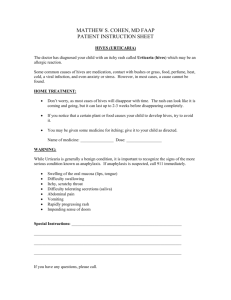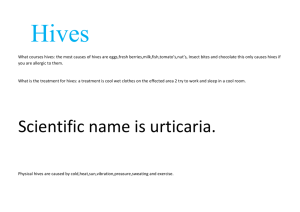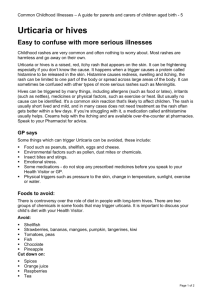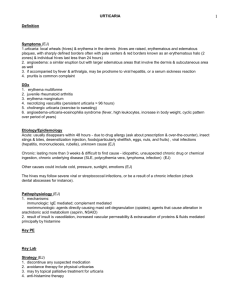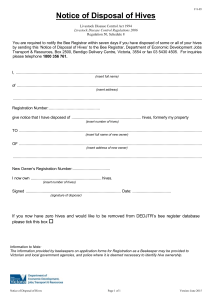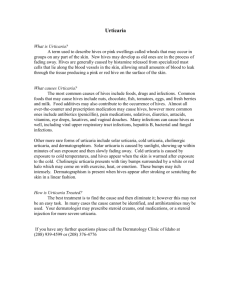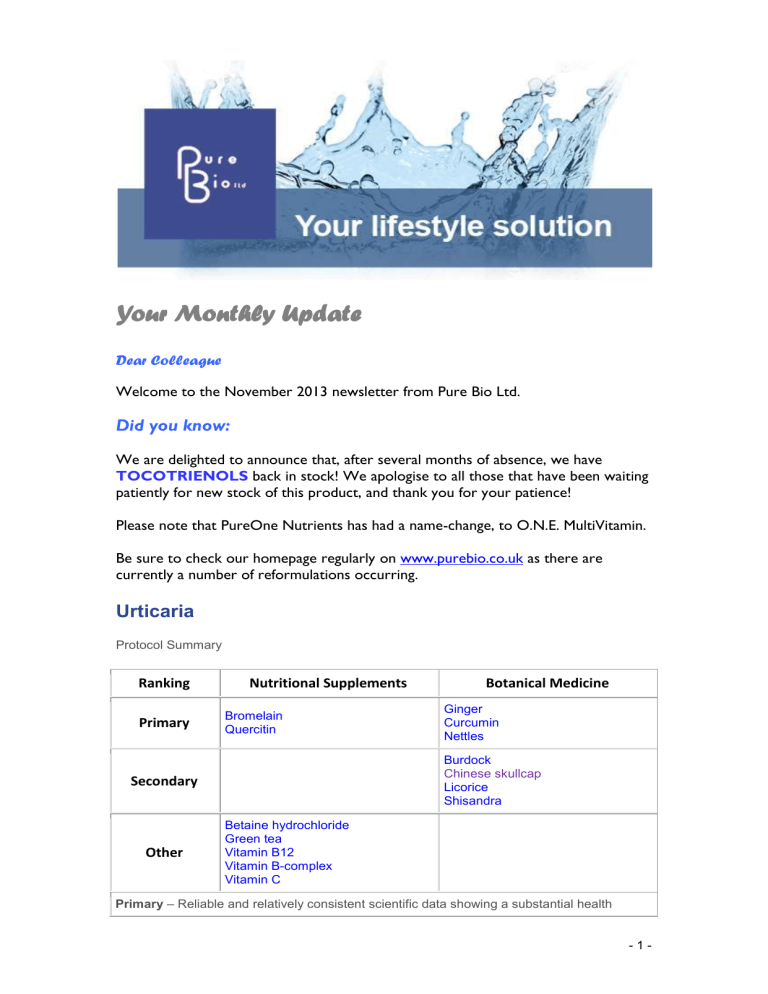
Your Monthly Update Dear Colleague Welcome to the November 2013 newsletter from Pure Bio Ltd. Did you know: We are delighted to announce that, after several months of absence, we have TOCOTRIENOLS back in stock! We apologise to all those that have been waiting patiently for new stock of this product, and thank you for your patience! Please note that PureOne Nutrients has had a name-change, to O.N.E. MultiVitamin. Be sure to check our homepage regularly on www.purebio.co.uk as there are currently a number of reformulations occurring. Urticaria Protocol Summary Ranking Primary Nutritional Supplements Bromelain Quercitin Ginger Curcumin Nettles Burdock Chinese skullcap Licorice Shisandra Secondary Other Botanical Medicine Betaine hydrochloride Green tea Vitamin B12 Vitamin B-complex Vitamin C Primary – Reliable and relatively consistent scientific data showing a substantial health -1- benefit. Secondary – Contradictory, insufficient, or preliminary studies suggesting a health benefit or minimal health benefit. Other – An herb is primarily supported by traditional use, or the herb or supplement has little scientific support and/or minimal health benefit. The Facts Urticaria is the medical term for the skin condition commonly known as hives. It is an allergic reaction in the skin characterized by white or pink welts or large bumps surrounded by redness. These welts are known as wheal and flare lesions and are caused primarily by the release of histamine (an allergy mediator) in the skin. About 50% of people with chronic hives develop angioedema—a deeper, more serious form of hives involving the tissue below the surface of the skin. While the basic cause of hives involves the release of histamine from white blood cells, what actually triggers this release can be a variety of factors, such as physical contact or pressure, heat (prickly heat rash), cold, water, autoimmune reactions, infectious organisms (e.g., hepatitis B virus, Candida albicans, and streptococcal bacteria), and allergies or sensitivities to drugs (especially antibiotics and aspirin), foods, and food additives. Urticaria is classified as acute or chronic, depending on how long the rash has been present. Acute urticaria is more common in children and young adults. The majority of acute urticaria episodes are idiopathic. If a cause can be found, it's likely to be an infection, food or drug allergy, or an insect sting. Acute hives usually resolve without intervention. Urticaria that occurs at least twice a week and has been present for more than 6 weeks is known as chronic urticaria. Unlike the acute type, chronic urticaria does not resolve quickly. In one study, 75% of people with chronic hives have symptoms for longer than 1 year; 50% have symptoms for longer than 5 years; and 20% have symptoms for decades. In 50% of the cases, the offending agent is not identified. Chronic urticaria occurs more often in middle-aged women and rarely occurs in children. It can be caused by the same things that cause acute urticaria. Other possible causes include autoimmune diseases, chronic infections, and any one or combination of the physical urticarias. Physical urticarias are caused by a specific stimulus like stroking the skin or exposure to cold. Symptoms Symptoms include an itchy skin rash with red bumps that can appear on the face, trunk of the body, and, sometimes, on the scalp, hands, or feet. Individual lesions usually last less than 24 hours and can change shape, fade, and then rapidly -2- reappear. People with hives may also have wheezing, or swelling of the eyelids, lips, tongue, or throat. Holistic options Psychological stress is often reported as a triggering factor in people with chronic hives. Stress may play an important role by decreasing the effectiveness of immune system mechanisms that would otherwise block allergic reactions. In a small preliminary trial of people with chronic hives, relaxation therapy and hypnosis were shown to provide significant benefit. People were given an audio tape and asked to use the relaxation techniques described on the tape at home. At a follow-up examination 5 to 14 months after the initial session, six people were free of hives and an additional seven reported improvement. Bicarbonate of soda baths (run a shallow bath containing no oils or perfumes and throw in two large handfuls of bicarbonate of soda; then soak in the water for 15 minutes) provide immediate relief from itching and also help to alkalinize the skin, preventing further irritation and burning. Aloe vera, applied topically, reduces inflammation and provides a protective coating to the skin. It is cooling to the tissues, relieves itching, redness, stinging and pain. Dietary Modification Allergy to foods and food additives is a common cause of hives, especially in chronic cases. The foods most often reported to trigger hives are dairy products, eggs, chicken, cured meat, alcoholic beverages, chocolate, citrus fruits, shellfish, and nuts. Food additives that have been shown to trigger hives include colourants (azo dyes), flavourings (salicylates), artificial sweeteners (aspartame), preservatives (benzoates, nitrites, sorbic acid), antioxidants (hydroxytoluene, sulfite, gallate), and emulsifiers/stabilizers (polysorbates, vegetable gums). Numerous clinical studies demonstrate that diets that are free of foods or food additives that commonly trigger allergic reactions typically produce significant reductions in symptoms in 50– 75% of people with chronic hives. Nutritional Supplement Treatment Options Bromelain – 500 – 2000mg in divided doses, with meals. Bromelain, extracted from pineapple, has been shown to be equally effective as an anti-inflammatory as OTC drugs in repeated trials. It decreases the allergic response and accelerates healing. Bromelain has been found to be non-toxic even in large doses. Quercetin – 500 – 1000mg in divided doses, between meals. Quercitin is a nontoxic, potent antihistamine bioflavonoid, which decreases inflammation caused by allergic skin conditions, as well as hay fever and asthma. Quercitin has shown to be useful both during an acute outbreak of urticaria or as a preventative measure. Betaine Hydrochloride – 325 – 650mg before meals. According to preliminary studies, lack of hydrochloric acid (HCl) secretion by the stomach is associated with -3- chronic hives, presumably as a result of increasing the likelihood of developing food allergies. In one such study, 31% were diagnosed as having achlorhydria, and 53% were shown to be hypochlorhydric. In a related study, treatment with an HCl supplement and a vitamin B-complex supplement helped to treat people with hives. Betaine HCl is the most commonly prescribed supplement containing hydrochloric acid. Green Tea – 200 – 400mg daily, in divided doses. Two components of green tea, the polyphenols epigallocatechin (EGC) and epicatechin gallate (ECG), are reported to have an antihistamine effect. Recommendation is approximately 3 cups of green tea per day or about 3 grams of soluble components providing roughly 240 to 320 mg of polyphenols daily. Vitamin B12 – Vitamin B12 has been reported to reduce the severity of acute hives as well as to reduce the frequency and severity of outbreaks in chronic cases. The amount used in these reported case studies was 1,000 mcg by injection per week. Whether taking B12 supplements orally would have these effects remains unknown. On rare occasions, vitamin B12 injections cause hives in susceptible people. Whether such reactions are actually triggered by exposure to large amounts of vitamin B12, or to the preservatives and other substances found in most vitamin B12 injections remains unclear. Vitamin B-Complex - In a preliminary study, treatment with an HCl supplement and a vitamin B-complex supplement helped to treat people with hives. Vitamin C – 2000mg daily. In theory, high amounts of vitamin C might help people with hives by lowering histamine levels. Amounts of at least 2,000 mg daily appear necessary to produce these effects. No research trials have yet explored the clinical effects of vitamin C supplementation in people with hives. Botanical Treatment Options Curcumin (Turmeric/Curcuma longa) – There is increasing amounts of research that confirms curcumin’s ability to stimulate the body’s production of its own antiinflammatory corticosteroids. It is therefore an effective natural antihistamine and antioxidant for hives and a variety of inflammatory skin ailments. Ginger (Zingiber officinale) – Clinical trials have shown that ginger has potent antiinflammatory and antihistamine effects. It also appears to relieve swelling and remove the inflammatory waste products associated with hives. Nettle (Urtica dioica) – Nettle has a fast-acting antihistamine function, providing symptomatic relief for hives. It is particularly effective in reducing associated oedema. Burdock (Arctium lappa) – Burdock assists in the clearance of cellular and lymphatic debris, and reduces tissue swelling. It has proven efficacy against skin problems such as hives, acne, boils, eczema and psoriasis. -4- Chinese Skullcap (Scutellaria baicalensis) - Chinese skullcap contains potent flavonoids that are anti-allergic and anti-inflammatory. It has a cooling effect on the heat and inflammation associated with hives. Licorice (Glycyrrhiza glabra) – Licorice has both antihistamine and anti-inflammatory properties, and increases levels of cortisone in the body. It can be used locally on the skin, or taken internally, or both. Use only under medical supervision in the case of high blood pressure *DGL form is not effective for allergy. Schisandra (Schisandra chinensis) – Shisandra has a long history of use in TCM to alleviate hives, eczema and swollen tissues. It is also classically used to enhance liver breakdown pathways, particularly in cases of chemical stress. For further information, contact: Tracy S Gates Director, PURE BIO LTD. 01403 730342 info@purebio.co.uk -5-
